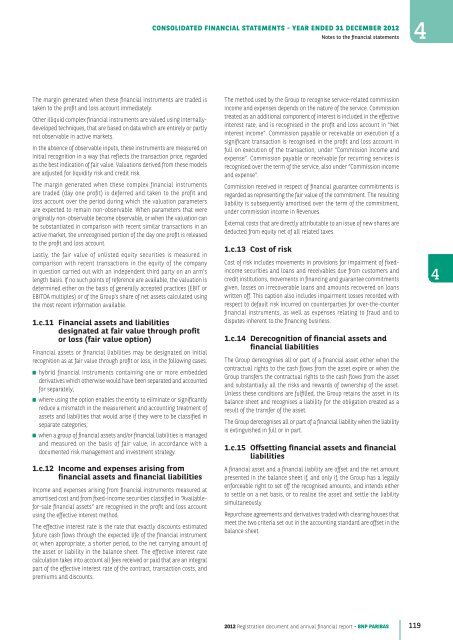2012 Registration document and annual financial report - BNP Paribas
2012 Registration document and annual financial report - BNP Paribas
2012 Registration document and annual financial report - BNP Paribas
- No tags were found...
You also want an ePaper? Increase the reach of your titles
YUMPU automatically turns print PDFs into web optimized ePapers that Google loves.
CONSOLIDATED FINANCIAL STATEMENTS - YEAR ENDED 31 DECEMBER <strong>2012</strong>Notes to the <strong>financial</strong> statements4The margin generated when these <strong>financial</strong> instruments are traded istaken to the profit <strong>and</strong> loss account immediately.Other illiquid complex <strong>financial</strong> instruments are valued using internallydevelopedtechniques, that are based on data which are entirely or partlynot observable in active markets.In the absence of observable inputs, these instruments are measured oninitial recognition in a way that reflects the transaction price, regardedas the best indication of fair value. Valuations derived from these modelsare adjusted for liquidity risk <strong>and</strong> credit risk.The margin generated when these complex <strong>financial</strong> instrumentsare traded (day one profit) is deferred <strong>and</strong> taken to the profit <strong>and</strong>loss account over the period during which the valuation parametersare expected to remain non-observable. When parameters that wereoriginally non-observable become observable, or when the valuation canbe substantiated in comparison with recent similar transactions in anactive market, the unrecognised portion of the day one profit is releasedto the profit <strong>and</strong> loss account.Lastly, the fair value of unlisted equity securities is measured incomparison with recent transactions in the equity of the companyin question carried out with an independent third party on an arm’slength basis. If no such points of reference are available, the valuation isdetermined either on the basis of generally accepted practices (EBIT orEBITDA multiples) or of the Group’s share of net assets calculated usingthe most recent information available.1.c.11 Financial assets <strong>and</strong> liabilitiesdesignated at fair value through profitor loss (fair value option)Financial assets or <strong>financial</strong> liabilities may be designated on initialrecognition as at fair value through profit or loss, in the following cases:■ hybrid <strong>financial</strong> instruments containing one or more embeddedderivatives which otherwise would have been separated <strong>and</strong> accountedfor separately;■ where using the option enables the entity to eliminate or significantlyreduce a mismatch in the measurement <strong>and</strong> accounting treatment ofassets <strong>and</strong> liabilities that would arise if they were to be classified inseparate categories;■ when a group of <strong>financial</strong> assets <strong>and</strong>/or <strong>financial</strong> liabilities is managed<strong>and</strong> measured on the basis of fair value, in accordance with a<strong>document</strong>ed risk management <strong>and</strong> investment strategy.1.c.12 Income <strong>and</strong> expenses arising from<strong>financial</strong> assets <strong>and</strong> <strong>financial</strong> liabilitiesIncome <strong>and</strong> expenses arising from <strong>financial</strong> instruments measured atamortised cost <strong>and</strong> from fixed-income securities classified in “Availablefor-sale<strong>financial</strong> assets” are recognised in the profit <strong>and</strong> loss accountusing the effective interest method.The effective interest rate is the rate that exactly discounts estimatedfuture cash flows through the expected life of the <strong>financial</strong> instrumentor, when appropriate, a shorter period, to the net carrying amount ofthe asset or liability in the balance sheet. The effective interest ratecalculation takes into account all fees received or paid that are an integralpart of the effective interest rate of the contract, transaction costs, <strong>and</strong>premiums <strong>and</strong> discounts.The method used by the Group to recognise service-related commissionincome <strong>and</strong> expenses depends on the nature of the service. Commissiontreated as an additional component of interest is included in the effectiveinterest rate, <strong>and</strong> is recognised in the profit <strong>and</strong> loss account in “Netinterest income”. Commission payable or receivable on execution of asignificant transaction is recognised in the profit <strong>and</strong> loss account infull on execution of the transaction, under “Commission income <strong>and</strong>expense”. Commission payable or receivable for recurring services isrecognised over the term of the service, also under “Commission income<strong>and</strong> expense”.Commission received in respect of <strong>financial</strong> guarantee commitments isregarded as representing the fair value of the commitment. The resultingliability is subsequently amortised over the term of the commitment,under commission income in Revenues.External costs that are directly attributable to an issue of new shares arededucted from equity net of all related taxes.1.c.13 Cost of riskCost of risk includes movements in provisions for impairment of fixedincomesecurities <strong>and</strong> loans <strong>and</strong> receivables due from customers <strong>and</strong>credit institutions, movements in financing <strong>and</strong> guarantee commitmentsgiven, losses on irrecoverable loans <strong>and</strong> amounts recovered on loanswritten off. This caption also includes impairment losses recorded withrespect to default risk incurred on counterparties for over-the-counter<strong>financial</strong> instruments, as well as expenses relating to fraud <strong>and</strong> todisputes inherent to the financing business.1.c.14 Derecognition of <strong>financial</strong> assets <strong>and</strong><strong>financial</strong> liabilitiesThe Group derecognises all or part of a <strong>financial</strong> asset either when thecontractual rights to the cash flows from the asset expire or when theGroup transfers the contractual rights to the cash flows from the asset<strong>and</strong> substantially all the risks <strong>and</strong> rewards of ownership of the asset.Unless these conditions are fulfilled, the Group retains the asset in itsbalance sheet <strong>and</strong> recognises a liability for the obligation created as aresult of the transfer of the asset.The Group derecognises all or part of a <strong>financial</strong> liability when the liabilityis extinguished in full or in part.1.c.15 Offsetting <strong>financial</strong> assets <strong>and</strong> <strong>financial</strong>liabilitiesA <strong>financial</strong> asset <strong>and</strong> a <strong>financial</strong> liability are offset <strong>and</strong> the net amountpresented in the balance sheet if, <strong>and</strong> only if, the Group has a legallyenforceable right to set off the recognised amounts, <strong>and</strong> intends eitherto settle on a net basis, or to realise the asset <strong>and</strong> settle the liabilitysimultaneously.Repurchase agreements <strong>and</strong> derivatives traded with clearing houses thatmeet the two criteria set out in the accounting st<strong>and</strong>ard are offset in thebalance sheet.4<strong>2012</strong> <strong>Registration</strong> <strong>document</strong> <strong>and</strong> <strong>annual</strong> <strong>financial</strong> <strong>report</strong> - <strong>BNP</strong> PARIBAS 119





